The best insects for your cannabis grow
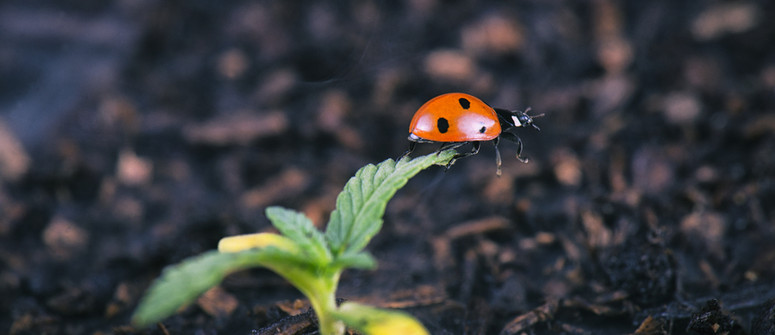
As the world moves towards more environmentally friendly practices, we all have to do our part. And growing weed is no different. With a little understanding of insects, we can grow organic cannabis, avoiding the use of toxic pesticides. And it makes your bud better too!
Contents:
We're becoming more and more aware of the terrible damage that pesticides are doing to our planet. And you have to wonder, before pesticides, how did plants not get totally devoured by herbivorous pests? Well, nature loves balance, and there are plenty of carnivorous critters out there who are more than happy to eat, drain and lay their eggs in these leaf-hungry insects.
An etymological note: there is no such thing as a pest. Though this article will refer to certain animals as pests, remember that that is a relationship between us and their actions. There is nothing inherently wrong with them – they're just surviving. So whilst we may take actions to reduce their populations when they try to eat what is ours, let's not assume that there is anything wrong with these animals.
Why Use Insects In Your Cannabis Garden?
It may seem counter-intuitive to introduce insects or fungi to your weed grow, but introducing the right species can have a range of benefits. Whether you want to reduce your environmental impact, fertilise your plants organically and for free, or attempt to prevent problems from happening in the first place, beneficial insects have got you covered.
You can use insects in any grow, but they are best suited to either greenhouses or outdoor growing operations. As these are living things with normal needs, they thrive in natural environments. The artificial nature of a tight, hot indoor grow can be too much for them. Or, if they thrive, you might find your house full of carnivorous insects. Whilst this may not be a major issue, it might not be the most pleasant experience in the world either.
Insects Are An Environmentally Friendly Pest Control
Do water sources really need to be contaminated with pesticides just so you can get high? It won't come as much of a surprise to people that the natural environment has taken a bit of a beating in the last few hundred years – nor should it come as a surprise that nature had itself balanced out before this.
There are many predatory insects around which are more than happy to valiantly guard your grow in return for a ready supply of food. The upside is that neither the soil in which you're growing nor the planet gets a toxic pesticide dose. Plus, you're going to make some predatory insects pretty happy along the way!
Insects Improve Soil Health
Not only do you save your soil from being poisoned, but you can actually make it a much richer environment for your plants to live in. The insects that you'll bring in – say a predatory nematode – will excrete waste into the soil that makes it even more habitable for your plant's roots. So they allow you to avoid the use of both chemical pesticides and artificial fertilisers, making your grow doubly sustainable.
Insects Are A Proactive Pest Prevention
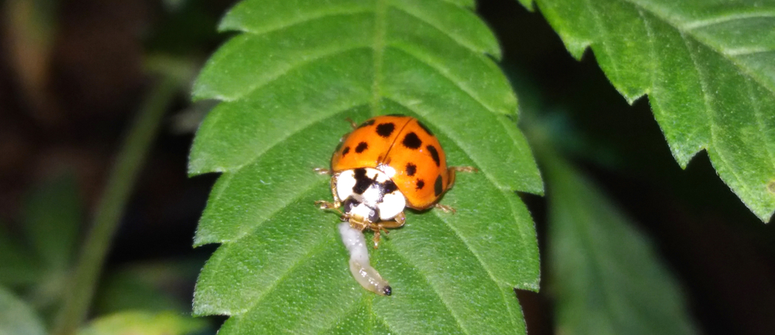
Get insects in your grow from day one and you'll likely never notice pests or infestations. If you keep their concentration high, they'll constantly be consuming populations of pests as and when they arrive. This makes your life so much easier, as dealing with a problem once it has occurred always involves a degree of loss. For instance, if you notice an infestation on a plant, it's best to remove it and isolate it to stop it spreading. This can often result in the death of a plant. Avoiding this is a much simpler, more effective route to satisfying yields and an easy grow.
How To Attract Beneficial Insects To Your Cannabis Garden
Specialist garden centres will sell the sorts of insects you'll want to introduce to your grow op. In this case, you can simply buy them. They usually come refrigerated, mimicking hibernation or as eggs. Depending on the species, you'll then either hang these close by and wait for them to hatch, or add them to the soil. It's likely they'll be so effective that you'll need to add them recurrently, as they'll eat all their food supplies and either move on or die off.
Alternatively, you can attract wild insects to your grow using plants that they find particularly alluring. The upside of this is that it's cheap and can bring in a balanced array of critters. The downside is just that, balance may not be as useful as a large concentration of predators.
Depending on your set-up will determine whether best to introduce beneficial insects or try and draw them in.
Companion Plants That Attract Beneficial Insects
Using other plants to attract insects to your grow is probably going to be easier if you're growing outdoors. Indeed, it's likely many of these plants will already be nearby. Whilst it is possible indoors, it may be worth giving the populations a boost with shop-bought ones as well.
Some beneficial companion plants are as follow:
• Purple dead nettle—It also provides one of the earliest sources of food for bees.
• Nasturtium—This acts as a form of sacrifice. Pests like eating it so much that they're likely to leave your other plants alone.
• Dandelion—You're likely to have some around already. Insects, including ladybirds (lady bugs) love dandelions and will come in droves.
• Dill—This herb attracts ladybirds and parasitic wasps (and you can eat it).
• Lavender—Attracts parasitic wasps.
• Mint—Attracts parasitic wasps and repels some pest insects.
(see below for why ladybirds and parasitic wasps are so good)
What Are The Best Insects To Help And Protect Cannabis Plants?
So without any further ado, which insects are the best for controlling pests in your grow?
Ladybugs
Everybody knows what these are, but did you know they're deadly to many of cannabis' least favourite pests? Voracious predators, they can consume up to 60 aphids a day. This makes them some of the top guardians for your cannabis. Get a few of them around, and you'll see aphid populations getting decimated.
But they're more versatile still. They'll also eat whiteflies, mites and weevils, to name a few. This capacity to hoovering up pests makes them a favourite among growers. Just make sure you keep an eye on your soil hydration, as they like to drink, too.
It's worth releasing them at dusk, or just before you switch the lights off, as they don't fly at night. That way, they'll nestle into your grow and call it home.
Assassin Bug
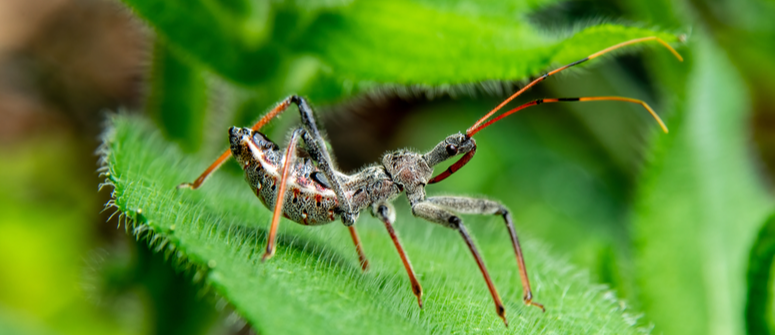
Assassin bug, also known as kissing bug, is the generic name given to any of the 3.000 members of the Reduviidae family. These are beautiful insects which look ready to kill. Using their rostrum, the mouthpart, they will spear their prey, injecting them with venom. Once the unfortunate victim is immobilised, they drain their insides. Pleasant, right?
Assassin bugs will actively patrol the grow, on the prowl for anything to suck dry. So getting these guys in your grow will surely keep pest numbers down. Just be aware that they really love to kill and will make quick work of any other above-ground predators you've introduced too. These bugs are predominantly found in the US and warmer climates, though they are now found in warmer areas of Europe as well.
Predatory Mites
Hypoaspic miles and Amblyseius andersoni are predatory mites which live in the soil. They rove about in the subterranean darkness and feast on larvae and pupae of thrips and fungus gnats. As such, they're a great addition to a grow, as they keep the roots safe from underground infestations.
Again, they like moisture. So water the soil well before adding them, and again a few hours later. This will ensure they get off to the best start.
Lacewing
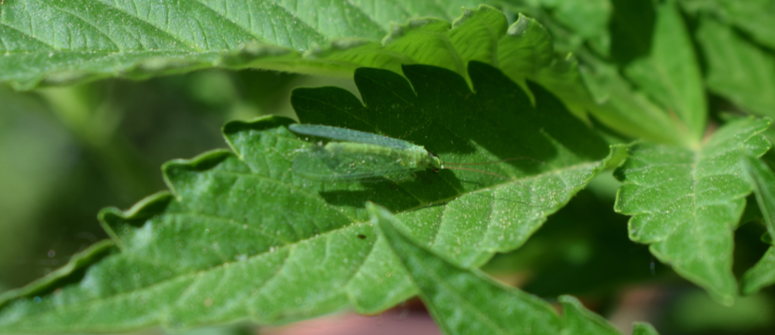
Green lacewings look innocent enough but are deadly to aphids and mealybugs. The larvae are especially vicious, so it's best to buy the eggs and release these, waiting for them to hatch. If you're doing this in an outdoor grow, keep them off the ground as they'll be fine prey for something else. And make sure you release them right away, as if they hatch with nothing to eat, they eat each other!
Praying Mantis
These are undoubtedly some of the most brutal and vicious animals alive. And they will protect your grow happily. When they mate, the female will often behead the male once he's done. They take the sub-dom relationship to the next level!
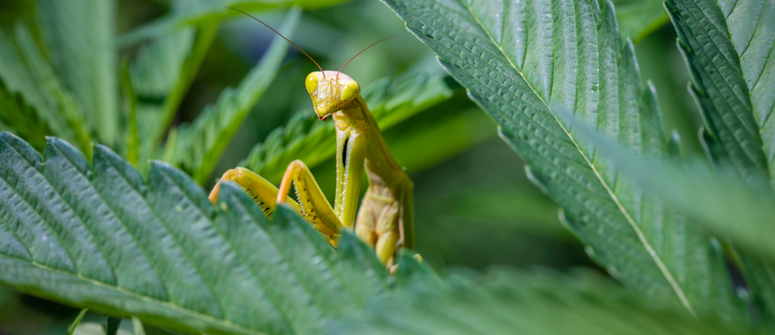
Hungry and aggressive, hang their eggs near your grow and they'll spread quickly once they hatch. Just give them space and plenty to eat, as they're not prejudice, and will eat one another as happily as they'll eat the pests.
Pill Bugs
These little creatures are less good for sorting out pest infestations, but are great for cleaning up the mess the more aggressive insects leave behind. They eat decaying matter – both plant and animal. As such, they catalyse the breakdown of organic matter on the soil, allowing it to be readily converted into sustenance for your plants. So they act as a natural fertiliser enhancer and keep your grow looking tidy, rather than littered with corpses.
Earthworms
Again, these are for fertilisation rather than pest control. Once decaying matter enters the soil, it could still do with being broken down some more. Earthworms will do this. Moreover, as they rove about, they create pathways that improve aeration and drainage.
Rove Beetles
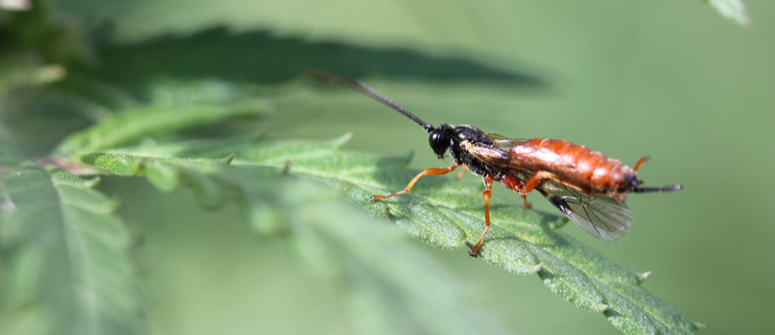
Previously known as Athetia coriaria, now Dalotia coriaria, these are soil dwelling insects with a thirst for blood. Though they are beetles, they have the appearance of earwigs that can fly. So not the most attractive insect in the world. If you've got a grow in a cupboard, maybe go for something a little less sinister.
Outdoors or in greenhouses, though, they are deadly and effective at both the larval and mature stages. They come (commercially) in numbers between 100 and 3000, and distribute themselves well throughout a grow space.
Delphi Bug
These eat whitefly eggs. Both the larvae and adults are useful, and equally hungry. Make sure you release them immediately on receipt, as they have a short life span if they're unable to eat and drink.
Nematodes
These are probably the most gruesome insects on our list. As parasitic worms, they burrow through the soil in search of their quarry, and when they find them, they inject their eggs into them and the larvae eat their host alive. Lovely! However, despite their demonic practices, they are fantastic at controlling fungus gnats, thrips and more!
Just be very careful you bring the right species of nematodes into your grow, as some can be incredibly destructive to plants. Steinernema feltiae is probably the most helpful species when it comes to controlling pests.
Beneficial Insects: The Organic Way Of Growing Cannabis
It's clear that introducing beneficial insects to a grow can be an incredibly effective way of controlling pests and stopping outbreaks before they happen.
But for the conscientious cannabis grower, they are a must. Saving the need to douse your plants in harmful pesticides, you're doing both yourself and the earth a favour. Do you really want toxic residue lingering on your smoke? Do you really want to flush poisonous chemicals into the earth?
This organic way of growing cannabis is taking hold even in serious, commercial growing operations now. Whilst it was met with scepticism at first, more and more growers are acknowledging the manifold benefits of using nature's hunters to our own advantage. If you're after great tasting weed with minimal environmental impact, get some predators on your bud!




